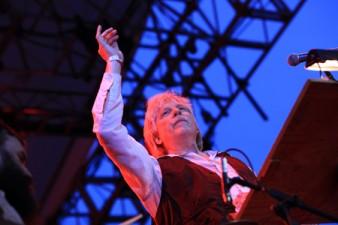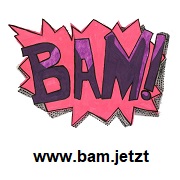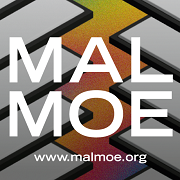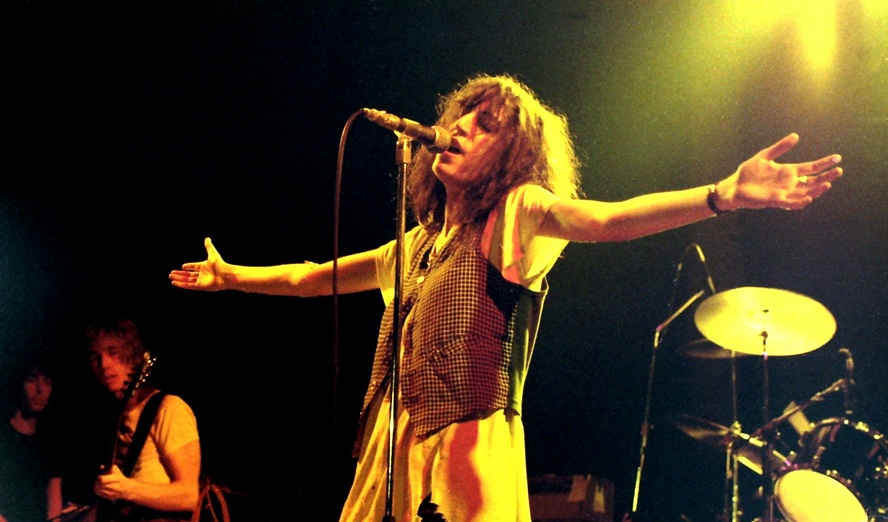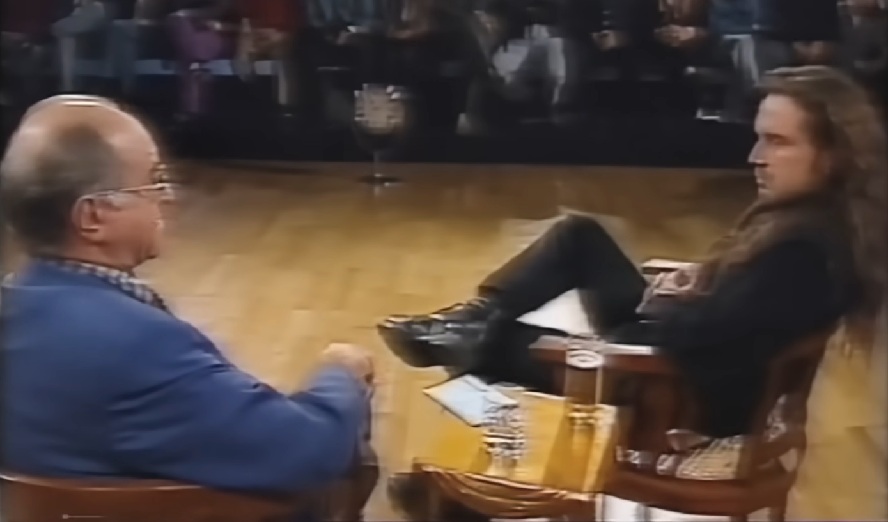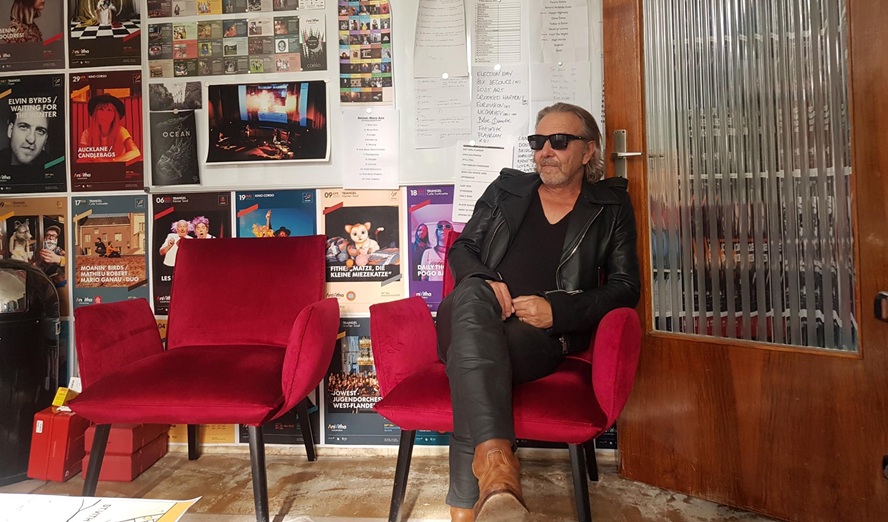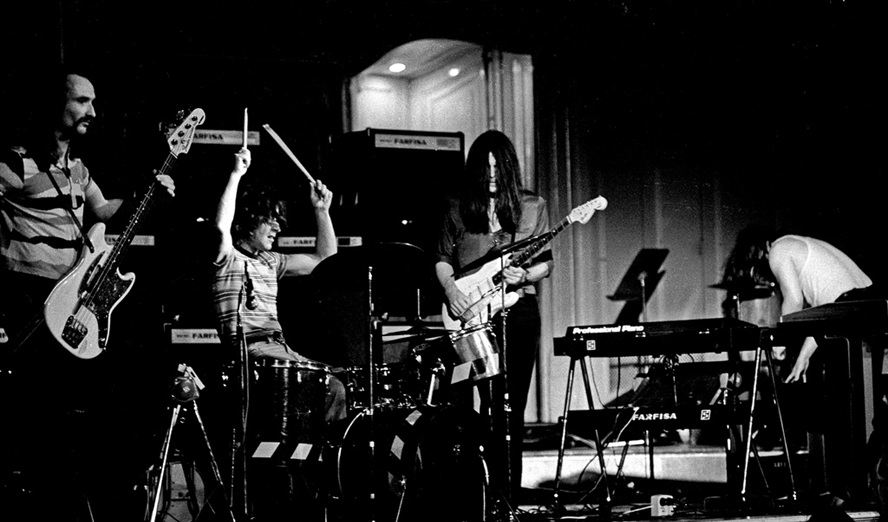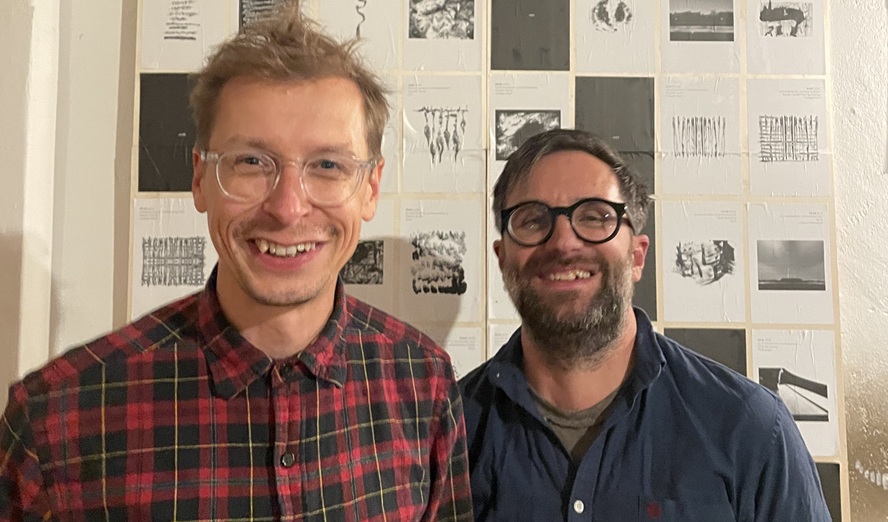»Guitar Trio (G3)« for numerous guitars, electric bass and drums was performed by Austrian musicians and Rhys Chatham with »Pictures for Music« by Robert Longo. Minimal music meets rock’n’roll! Pure grandezza with fabulous overtones and harmonics!
Questions by Alfred Pranzl, intermezzi by Magdalena Blaszczuk (MB), who took photos for the article in skug, vol. 78, 4-6/2009. Audiotranscription: Doris Hutterer.
Alfred Pranzl: First I’ll show you an old skug issue with my interview about La Monte Young.
Rhys Chatham: Oh, I remember, this was when La Monte played with the Forever Bad Blues Band.
So, let’s test the recording. Test.
Testing, one, two, one, two. Testing, testing … I like people who like to listen to themselves and I don’t know if you have a good level now, but ah …
Okay, let’s start maybe with the very early days: Tony Conrad was in Vienna, invited by the Wien Modern festival – it’s a new music festival – and I was talking to him and he told me that you were really important for the pop music scene to bring the idea of minimal music into it. What is your part?
Well, my relationship with Tony goes way way back. He invited me to be in his group in 1971, so that gives you little bit idea of my age, but please don’t tell anybody …
MB: I was born ’71!
Oh my god! I was very young in 1971. In any case, I played one of these special instruments in a place that I founded in New York City, called The Kitchen. I started the music programme there. Do you know this place The Kitchen? No? It’s a place in New York and it still exists. The problem was composers (in France we say there is this musique contemporaine … you know, this music like Boulez and Stockhausen). If you are writing music like La Monte Young or Tony Conrad or Philip Glass or Steve Reich – no place to play! So I needed a place to play myself. I was a student at that time at New York University, and there was no place for these composers to play there, playing in lofts in SoHo. It was in a very slick art centre where theatre people like Richard Foreman would play, The New York Dolls would play there in different theatres. I worked with two video artists named Woody and Steina, who were into electronic image at that time and working with Andy Warhol, and they started this place, The Kitchen, and they said, »Rhys, we need music here.« And I said, »Okay.« And sure I was a student these times. And so I invited all my friends to play there; and then I worked up the courage and called on the telephone Tony Conrad and asked him if he would like to play. I was scared of him, because he was like very – you know in the underground scene, he was an underground filmmaker doing this film called »The Flicker« and he had played with La Monte Young in the sixties, with John Cale when he was in the band, and Terry Riley and so … I got to meet Tony and Tony said, »Oh, I want you to play in my group.« I was so pleased and we did that performances at The Kitchen. By answering your question and talking about Tony … I think what you wanted to know was how I did affect pop music – I did not affect pop music. With working in this strict definition of pop music – I don’t know, I don’t think I affected it at all. Pop music for me is … I think Elton John is pop music.
MB: I think he meant No Wave …
Ah, who did this song »Bam, bam, bam, bam«, like psychedelic rock … »Dadada-da, dadada …« … [all laughing] … no, that’s not pop at all. No, I don’t think I affected them.
But wasn’t it something like »No New York« stuff?
But that’s not pop music.
That was pop somehow. Another style …
You mean popular music? In the broadest sense of the term.
Popular music, yes.
Because pop music is a very specific genre, that’s why I got confused about what you were saying. This is a very good question! I know what you are asking. You have to realise, at the end of the sixties – I’m a composer coming out of a classical tradition, I was coming out of a conservatory – the question all of us were asking at the end of the sixties, at the beginning of the seventies, was: music had reached a point, coming out of academia, it had become so complicated that it seemed that, in order to understand it, one needed a master’s degree in music; or at least be involved with someone who had a master’s degree. And it seemed to be getting very, very out of touch with real people, so a number of us started asking … We saw the experience that La Monte Young was doing with Tony Conrad, who were kind of reinventing tonality. If you are a young composer in 1965 and you are writing tonal music (tonal music means: like popular music), it was considered … no one was interested! You had to write something like serial music, you know, what was hip. Serial music, very atonal, pointillistic, the noisier the better … But then we started realising not many people could appreciate it. There is such a point that you had a composer like Milton Babbitt, he worded his article in »High Fidelity« called »Who cares, if you understand?« Or you had a composer like Charles Wuorinen, who is a very well known musique contemporaine composer in America, saying: »The actual performance of the music is a necessary evil.« This is how these guys were talking! So a number of us started thinking, like Terry Riley, Steve Reich, like Philip Glass and Tony and Charlemagne Palestine, composers like this were thinking: we want to make music that’s accessible to people. But if they have the masters‘ degree, it’s okay too.
It’s not a must that it’s in a very small circle.
What?
They wanted to get out of the small circles.
They wanted to get out of the small circle and bring their music to a wider audience. I can’t begin to tell you what an issue this was for these composers. I was a 19 year old kid while they were dealing with this issue. They were all my uncles, big brothers – you know, figures to me. We all lived in SoHo in the same neighbourhood. I was a kid on the block. But this is what they were thinking about, so you had Terry Riley. You know his organ pieces? »A Rainbow in Curved Air« is an attempt to try to break out, you know, of this ghetto, this intellectual ghetto. It wasn’t entire intellectual, it wasn’t nihilistic – it was exactly the opposite. When I first heard Terry Riley, it was at a place called The Electric Circus in 1968 (a lot of things happened in 1968). I had seen Terry, a score of his. It looked like a piece by John Cage, like little pieces of ink spots, like very, very noisy. When I went to The Electric Circus, I think I was 16 at that time, I paid five dollars, what is a lot of money for a 16-year old, and I heard this guy with long red hair, playing this circus organ, kind of it … I said, »What is this?« So I tried to get my money back [all laughing]. I was furious … hearing something that is noisy, you know, tonal music?! Oh my god, it was horrible. And I tried to get my money back, but they wouldn’t give it to me, so I said, »Ah, I go back and listen.« And by the time, two hours later, I was a minimalist. And that’s how it happened. I decided I liked it.
It’s good that they sent you back …
Yeah, it had changed my life and it was an epiphany! Then, when I was older, I was 19, I founded the music programme at The Kitchen. I invited Tony to play there, … what I’m trying to say, these guys were really formative for me. I got completely influenced by it, you know, I heard new music and read his writing the way only a 19-year old can. I read La Monte Young’s »Selective Writings«, just like Jean-Paul Sartre’s »The Transcendence of the Ego« or »Being and Nothingness« for the first time. ‚cause it’s complicated for the first time. And then finally I met La Mont
e. I was a piano tuner, that’s how I supported myself while at university, and I heard his piece, »The Well-Tuned Piano«; he played me a tape, not the new version but an older version from ’64. And I said to La Monte Young, »I think it’s a little bit out of tune, I think I could tune it better.« And he laughed, because he knew I was trying to get composition lessons from him for free, in exchange, and he knew exactly what was going on, but he was nice and so he let me tune his piano and he gave me composition lessons in exchange for doing that. So I studied with him and I eventually sang in his group. I was in La Monte’s group and I was in Tony’s group and, finally, that’s what really influenced me.
La Monte’s group, how was it called?
It’s called The Theater of Eternal Music.
Which instrument did you play? Trumpet?
No, no, no.
Trumpet came later?
Yes, trumpet came later. I met La Monte because I was studying with Pandit Pran Nath, his Indian guru, okay. And so I studied voice.
Oh really?
Yeah. And when I studied with La Monte, I sang in his group. I was one of the singers. And in that group were Jon Hassell on trumpet, Garrett List on trombone and me and Marian Zazeela and La Monte on voice. That was wild. That was like … Because you have to tune to this sine wave frequencies that you are hearing, but the properness … This was back in the early seventies, so we smoked massive amounts of things [laughing] and that high I tried to tune to these very precise intervals that were generated by sine wave generators. The synapses in the ear can’t really posit them, and so they appeared to drift. And even without smoking anything it’s a psychedelic experience to try to tune to these things for three hours. It was like amazing. But by the time, it was 1975, I felt, you know, I was still a student, and I felt I needed to find my own voice. And so I left La Monte’s group and left Tony’s group and started looking around. And then I had another epiphany: a composer friend of mine took me to this new club I had never heard about before. It was called CBGB’s – nobody had heard of it – it was in May 1976 and I had never been to a rock concert before.
Is that really true?
When I grew up, when I was 16, I was playing Pierre Boulez on the flute or piano. I was a flute player. Or Edgar Varèse, etc. etc. Of course, I listened to The Velvet Underground on records, to The Rolling Stones, and The Beatles, but my passion was contemporary music. And then I became a minimalist. But by the time when I was 25, a composer friend said, »Rhys, you have never been to a rock club? Come on down, we go to see CBGB’s, there is this good band playing tonight.« So I went and the band that was playing was The Ramones [all laughing]. They had just released their first album, which was entitled »The Ramones«. They released it, I believe, in April 1976. I heard them in May 1976 and they were really tight and they were fantastic. And I said, »Man, this group is doing things a lot more complex than me. I’m playing one chord, they are playing three chords. I don’t know if I can really have this technical capacity …« but I felt a lot in common with it. Phil Glass had his jazz instrumentations, his »Music in Twelve Parts«, »Music and Changing Parts«. And Steve Reich was incorporating Ghanaians, rhythms from Ghana. So I said: »What am I gonna do? I don’t know, some of my age … I should be playing rock’n’roll!« The next day I went to a composer friend of mine, who had a Telecaster he was not using, and he lent it to me. I learned how to play bar chords and then soon after I played in a legitimate punk band. You know, it wasn’t my band, I just saw I could really not be a composer functioning as a secret agent within the context. One fact, I was a secret agent, but there was this big thing back then – posing. I knew I could do a rock-influenced piece at a place like The Kitchen. No problem. John Cage can play there. La Monte has a piece called »Feed a piano a bale of hay« or »Let a butterfly out of the jar« and that’s the piece. If he can do that or John Cage can do »Silence«, you know, of course I can play a rock-influenced piece. But the question was, could I do a real composition that was minimalist, working with overtones in the same way I did when I was tuning La Monte’s piano? Yeah, I had a real rock influence – could I play at Max’s Kansas City or could I play at CBGB’s? Because the audiences there, even if they liked you, they would throw beer at you. And if they didn’t like you – forget about it! It was wild, that was the punk period. And the first time we played – it was at Max’s – I was really nervous … Who was in the band? It was Glenn Branca, me … I gave him his first guitar that was in a special tuning, and I met him in a band …
Who else was playing in your band?
Nina Canal from Ut played guitar – they are part of the No Wave thing, it’s an all girl band – and Wharton Tiers, he was on drums.
And how was the band called?
It might have been called Tone Death.
And you played at CBGB’s? At what time?
No, first we played at Max’s Kansas City. ’77, no ’78. The first performance was at a place called Franklin Furnace – that was in ’77 – then there were some other performances in ’77, in lofts, because the only two places for doing punk rock were Max’s and CBGB’s, it was a long line to get invited to play there, what was like a big thing. We finally got invited, I think in ’78 and ah, I was nervous, because »was it bullshit what I was doing?« Like »this composer from a classical tradition« – I mean the kids did not wanna hear about that. I mean, if it wasn’t rock, forget about it. But it was very important to me that the work that I did was completely true to coming from me as a composer but at the same time completely true to the rock’n’music that I loved. So we played there and the kids were coming up saying, »Where are you hiding the singers? We are hearing singers.« They were hearing the overtones, but they liked it! It was like »Phhhhhhuuuuuuhhhhhh!« [all laughing]
So it was a pre-stadium of what you are playing at Tanzquartier Wien tomorrow?
Oh no, what we are playing tomorrow is what we played back then.
Aha. No, I mean, what did you play? Did you play this long stretched things already in this band?
Okay, even before we played at Max’s … with Nina … And Wharton. Wharton would just play hi-hat. We did something at the Peter Nadin Gallery, just celebrate an opening by the French artist Daniel Buren, B-U-R-E-N. He does things with stripes … And so we just strummed on one chord, we played half an hour, and he was just playing hi-hat. Then we stopped, and then we played for another half hour. Exactly the same thing but different, because when you listen to these overtones, they are telling a story, but somehow it’s your story, because depending on where you are in the room, everyone hears something different.
It differs, yes.
And where your consciousness is – listening in one area and hearing one thing, where another person right next to you might be focusing on a different area. So it’s a kind of completely … trying to tell another story … So then we started … we did basically the same thing at Max’s and CB’s. Then in the eighties, the pieces started getting shorter and shorter. And I don’t know the number of times we did other pieces. We did a piece called »Drastic Classicism« for a choreographer, Karole Armitage, she used to work with Merce Cunningham and is a beautiful, beautiful dancer and fantastic choreographer. And she was the first person brave enough to work with, you know, a sound like this, and it really caused this sensation. It was 1981, in New York at Dance Theater Workshop, and we had four electric guitar
s, with the bottom strings tuned in minor seconds – D, no, C sharp, D, D sharp, E – and all the other strings tuned in highly dissonant tunings, and a cumulative effect was like a Chinese gong. We are over a very powerful drummer. And Karole was very, very brave to dance in a context like that. The result was fantastic. And I’m answering your question directly now: this was one of the pieces, I’m really proud to say, that started the noise rock scene in New York because … it was noisy!
And do you mean with noise rock the »No New York« thing, or … What do you mean exactly with …
No, »No New York« is not noise. »No New York« is No Wave. First you have punk.
You mean like Sonic Youth, but that was later?
No, no, no. Okay, punk – it was Ramones, Television, Patti Smith. Then you had new wave and that was like Talking Heads.
Blondie and so …
Yes. And after new wave you had No Wave, what was named by Brian Eno for that album he did with Mars, Contortions, DNA …
Lydia Lunch had also a band.
Ah, Lydia Lunch – Teenage Jesus & the Jerks, of course. And Brian also invited me to be on there, but I forgot about the recording, so I didn’t show up … I didn’t think it was important, so … [laughing]
Really?
Yes. Actually there was a very serious night the night before – at a danceteria, and I was up till 7 o’clock in the morning and I couldn’t make it. I overslept, what can I do? But I was part of that No Wave scene and I never felt myself as part of the No Wave scene. I felt myself as a composer, working as a kind of secret agent in a rock context. And, ah, … So after this, you know, other people like Glenn, my friend Glenn Branca, who was working with me and then Theoretical Girls and then he had his own rock group, I can’t remember the name of that. But then he liked the idea of compositional things too, so he started working compositionally with his own motto on electric guitars.
Glenn was not a composer originally?
No, he is coming out of theatre. He was always interested in sound, always. So it’s normal for him, too, he is very interested to follow this progression. The time is preliminary rock and he moved into, but we were part of this No Wave thing; and then after that, coming out of that, you had groups like Swans and Sonic Youth.
This you mean with noise rock scene?
And I think the first time that we started calling it »noise« was for a festival that was done at a place called White Columns in New York. And all these people played there – you know, Glenn, me, Sonic Youth, Swans. And we called it noise. Now I don’t consider my music noise. I consider my music [disguises his voice] beautiful. But noise is beautiful. But when we think of noise, you know, we think of something … my concern has always been more overtones. So people who hear overtones and harmonics, they hear that in the compositions, but it’s kind of loud what I do, and so other people might hear this: noise. So again, it’s in the mind of the listener.
For me it’s interesting – I also did an interview with Glenn Branca and he worked also with very huge guitar ensembles … Could you describe the difference? You have more …
Okay, my first piece for 100 electric guitars was in 1989. It’s called »An Angel Moves Too Fast To See«. I have moved to France; Glenn I think wrote a piece for 100 electric guitars – when was it? In 1998 or something like that …
Really?
Yeah, I have been doing it for ten years and he didn’t want to do it, because he didn’t want people to say that he was imitating me. But no one has a copyright on an orchestration, so I’m really, really glad that he was finally bravin‘ up to do one of his own, ‚cause he really should, ‚cause he has a history in doing that kind of thing. Do you know who a composer named Virgil Thomson is?
No.
He was an American composer around the time of Gertrude Stein – used to hang up with her in Paris. He wrote for the Herald Tribune when the Herald Tribune was as big as The New York Times. He was a music critic. And he wrote something very funny: »A composer under 30 is politely familiar with his colleagues‘ work, a composer over 30 is politely unfamiliar.« You understand? It’s a joke, but I’m not sure that I know Glenn’s music well. I knew his music of course, you know, when we were doing things together back in the 80s.
Glenn had members of Sonic Youth playing in his ensemble in the early days. It was called Glenn Branca Ensemble?!
Yeah, that was a small ensemble of ten people.
Yes, and it was just guitars, a drummer and maybe a bass player.
Yes, it was called »Symphony No. 1«. I remember that piece. Yeah, really nice piece. Really, really good.
So you never thought you were competitors?
Of course we were competitors. We are doing exactly the same thing [all laughing].
Somehow yes.
The thing between me and Glenn is like between Phil Glass and Steve Reich. I mean, of course the two have music in common, but you know, Phil is Phil and Steve is Steve. Glenn and I are often compared, because we are working with similar instrumentations constantly.
Is he still working on new symphonies?
Yeah, for 100 guitars. The last thing he did, called »Hallucination«, was a symphony. I don’t remember which number.
Because here in Europe, if he does a new record, we don’t find out really …
I can’t speak for Glenn. You know, you have to ask him.
It’s also the same with you. When you bring out new records on Table of the Elements, you really must be specialised to get it in your head … to read it somewhere.
Here is how I say we are different for the 100-guitar pieces: »An Angel Moves Too Fast To See«, which was my first piece for 100 guitars from 1989 – it’s music for everyone, like often when I perform there are a hundred guitars, many amateur musicians. We rehearse the music in five rehearsals and we become a small community, it’s really, really beautiful.
Even when it’s hundred people?
Oh yeah, I mean, consider: classical musicians can play in orchestras, guitarists don’t. The most in a band, you have two guitars. So, what happens every time we do this piece – and we have done it around 50 times, you know, since 1989 – is all the people are networking. We played in Portugal and the guy who organised it was a wonder guitarist named Rafael Toral. He was the organiser and then he saw this cute girl there, one of the guitarists, and one thing … they got married and now they have a kid … it’s from 100 guitars where he met is wife!
I got a new CD from him. I should review it. For me it sounds complicated what he does.
I don’t know. Just to give you an idea what happens in this. And then the thing is you have all these people playing, and their parents come, and brothers and sisters come, and so I knew that and I wrote this music in such a way. Whereas before with »Guitar Trio«, it’s kind of as you are saying: specialised music. You have to like minimalism to like »Guitar«. You can still appreciate it, you don’t have to be a minimalist to really appreciate it, because you can just open your ears. But, still, it’s hardcore! Whereas with an »An Angel Moves Too Fast To See«, if you like rock, you like that piece. You know, I see heavy metal kids and they are digging it, but there grandmother is digging it also [all laughing].
Really? That’s fantastic!
It’s just amazing. Whereas with Glenn, what he is doing, it’s really specialised music. It’s for specialists. And Glenn is really, rea
lly concerned with tuning systems. We just had a talk about this, an interaction, that’s why I can say this … we are trying to define. We are saying: »Come on, let’s delineate how are we different?« And what we came up with is: when I’m working with overtones, it’s more overtones the way a piano tuner hears them. I just play the stuff – when you hear »Guitar Trio«, we are just playing E.
Just one chord?
Just one chord – but all the music is happening in the overtones; and through picking techniques. Whereas what Glenn will do is he works directly on the fretboard, you know, with this very specialised tuning systems, that’s how we are different. I work on the fretboard, too, but I’m not so concerned with tuning systems in a way in these pieces. More I’m concerned just with counterpoint.
Also Sonic Youth tuned their instruments in different tunings. They are coming from Glenn Branca.
They played in his ensemble, they have played with me also.
Also?
Of course, yeah. But the tuning idea and stuff like that they got from Glenn. To be an egomaniac, without »Guitar Trio« it would not have started. I gave Glenn a guitar and said, »It’s overtones, listen to them! We gonna be working with overtones.« He said, »Wow!« You know, it didn’t take a long time … after three performances he started his own band with special tones, you know. He is talented, he learns very, very quickly. But I can say with considerable pride »Guitar Trio« started all this. And what I was doing before was using it as a signature piece, after I did a whole programme, you know, I do a six-minute version. But then we were in Atlanta/Georgia, and I have a heavy metal band also, it’s called Essentials, and we did a 13-city tour in America.
When was this?
This was two years ago. But we still haven’t put the record out because the record producer from Table of the Elements said, »Look, here in Atlanta there are a lot of good musicians – why aren’t you doing the original version of »Guitar Trio« with these musicians?« Okay, why not? And we did it. And we liked it. It’s like that and then we said, we should tour this. And so we toured it in a lot of cities. For that album »G3 Is My Life« … in New York I asked my friends to play, everybody from Sonic Youth played, Kim and Thurston and Lee, and we played in Chicago and all the guys from Tortoise – they are really good musicians – and US Maple and Bullshit played. And I was scared to death, because of theses guys from Tortoise, man … But they are sweet, they are really nice. And you know Hüsker Dü?
Yeah, yeah, yeah.
The bass player from Hüsker Dü played in Minneapolis. We had these fabulous musicians. Godspeed You! Black Emperor in Montreal. Yeah, all those guys.
Really? That’s fantastic!
And we put the record out. We thought we’d do it in Europe.
That’s a good idea.
‚cause the thing is – it was so beautiful playing with a hundred guitars in this community – but the thing is that it is expensive to organise all of that.
So many amps …
Yeah, just the whole thing and learning all the rehearsals and then I insisted that musicians are fed, you know, catering and stuff like that. That costs money. But we thought »Guitar Trio« … it’s a kind of smaller version of it, you know, like in Vienna we will have ten musicians. And I don’t know these guys. Then I get to meet them and every time we play this in an European city, you know, we all meet each other, exchange ideas and it’s just a beautiful experience.
Is there a difference – you have been to many cities – is it easy to learn this piece?
Yes.
Is there somewhere in the world where it took longer to learn it?
It’s easier if you are a good musician. You have to really be able to play to play this piece. We did it in an art school in Valence in France where the kids were really guitar players and it took a week.
Really, because …
Yeah, working like four hours a day. And the drummer and the bass player, you know, were rehearsing extra and … so it took a full week. Because they were not fully formed as musicians. The better the more talented the musicians are. Good musicians can hear. And so, for example, when I do a tremolo, in Chicago with Tortoise – they didn’t even think about it. They started doing the tremolo. And then we stopped … it just went back and forth, because they are fabulous, very enthusiastic musicians! Because of this, if you listen to the record, it’s crazy this record, it’s three CDs of exactly the same piece, half an hour each. You got like three hours of different versions of »Guitar Trio«. And they all are really different. I don’t know if you have experienced it.
I just want to know is there a difference? The most guitars you had were 400 in France. Is there a big difference in the sound compared with 100 guitars?
It’s a good question. It’s a completely different piece. The answer to your question is: yes, it’s a different sound, but the reason for these large numbers is, because the piece you are thinking about is called »A Crimson Grail«.
It’s written for that?
It was expressly written for Sacré-Coeur and I what I wanted to do is surround the audience with guitars, so I needed 400 to do that.
It was in a hall?
It was in the cathedral. Inside. We did a part of it outside, but we did »Crimson Grail«, we did »An Angel Moves Too Fast To See«, it was Nuit Blanche, you know, that goes on the whole night – so we played from 7 in the night till 7 in the morning.
Such a long time?
Yeah. We played for half an hour – I made a deal with the bishop. He said it’s too loud. I said, »Don’t worry, I’m gonna make music to pray to.« And he said, »I don’t believe.« And I, »Seriously.« And then he said, »Okay, I make you a deal, you play for half an hour and then we pray for half an hour.« I said okay, and then he signed the contract and he said to me, »Rhys, I’ll see how much praying I can do during that half hour.« And I don’t think he was doing much praying, to tell you the truth. But it was really a fantastic experience.
MB: When you go to Poland you get the people to pray.
I wanted to go to Poland, then we can have the people pray.
You have never played there?
No, I haven’t.
You should!
I can’t wait. But we did it at Lincoln Center last summer and it was in an outdoor space. I had to rewrite this piece for outdoors. But I only needed 200 to surround the audience and it sounded fine with 200. In fact, with 200 I was afraid for that performance, because there is no amplification except the guitar amps and it was outdoors. It can eat up sound. But we started playing, and about a thousand people from the street showed up to listen to it and it was just awesome. The people from the park department said, »You have to turn it down by half, because if you play this level for more than 13 seconds, people would sustain permanent hearing damage.« I already have permanent hearing damage, so we turned it down. So the sounds are very different between these … but for this piece, it’s simply a requirement to the space.
And your label is still Table of the Elements? Are you working on new records?
It might be called Radium Records yet.
Yeah.
Yeah, I mean, it’s still the Table of the Elements owner and it’s like a subsidiary. I can look on my records and see.
What are the next plans?
I have written a new piece. The next album that comes out is from my heavy metal group called
Essentialist, which is based on overtones but it really is heavy metal. The inspiration for that were bands like Sleep, Om, Sunn O))) …
Yes, I know.
Stephen O’Malley is a friend of mine, he is living in Paris now. And, you know, groups like that. You know this piece »Dopesmoker« by Sleep?
No.
No? Oh man, I got a new info free for you.
I must buy it.
No, just download it. So, they had a major record deal and, you know, it was like lots of money they spent also on dope smoking and they needed this one piece that lasts 63 minutes. You know, that was like one song. And it was fantastic. You listen to what we call – I think the genre is called drone metal.
Drone metal, yes.
And, once, it started back in 1990 and you hear it and you think it is in 4/4 but then you count and it isn’t. In fact, what they were doing, you know, they had this different rhythmic values and as they were playing they went around the room over the hour looking at the score. So they gave it to their record company and the record company hated it. Because you can’t sell that piece, it’s 63 minutes long. So they made them split it into shorter things, which I think they called it »Jerusalem«. And after the deal run-off, after five years, they re-released it in the original version called »Dopesmoker«, which you can find on Apple music store. You must listen to it. So I was in a tour van, you know, doing the »Guitar Trio« thing, and I heard it and I said: »Oh man, this is my music. I got to do something like this.« And Jeff Hunt, the owner of Table of the Elements: »Rhys, do you have a metal band like that? I produce it and, you know, take care of the van.« And that’s how it started. You know, it’s funny, because those guys, they say they are influenced by me, you know, and Steve Reich with »Guitar Trio«. Now it’s turned full circle and I’m completely influenced by them. Really funny.
That’s fantastic. And Stephen O’Malley is doing a duo with Peter Rehberg.
Oh, what name is the group called? KTL? Something like this? It’s fantastic! I saw it live.
But they put all this guitar stuff into the computer. Do you think the technique will progress that you can do something with a computer which is 400 guitarists?
Have you heard it live?
Yes, I have experienced it. And how is it for you?
It sounds like 400 guitars. I mean, it’s like – that is what went to my mind when I first heard it, I said, this sounds like a 100 guitars. How is Stephen doing it? I had never heard anything like that. I heard it in Paris, you know, in this little club.
They are multilayering …
With Stephen and what’s the guy’s name?
Peter Rehberg.
Peter, yeah. And they were great. I don’t know, I try to look at the thing, you know, I imagine it’s got a lot of stuff in the computer, but it just sounds great on stage. And it’s really fresh, and it’s really new.
Would you say it sounds different, but you really hear overtones?
Of course.
But not the same, I think.
Stephen has his own unique approach. He is coming from a very special place, from the Sunn O))) kind of place and he is still working with Sunn O))) and now he is doing his own compositions and is thinking completely in terms of oral art, and I just think it’s fantastic what he is doing with his group, what he is doing with Peter.
Yes, that’s true.
You know this group too?
MB: Yeah, They were in Vienna.
Try to hear them live. It’s even more powerful. Always working with smoke machines [all laughing].
I really like that you play trumpet …
Do you know these pieces?
I have just heard one today on your MySpace site.
Oh yes, that thing. But I have a site I can give you where you can find the other ones.
And this was with people – you can say from Dancefloor music? But this music you do is different. This is … how would you call it?
Well, in the early nineties, I was losing my hearing from playing trumpet, no, guitar, so I stopped playing guitar and went completely to playing trumpet. Back in the nineties we had a shift of music, the interest for me in music was in Europe, whereas for me it was before in America through minimalism and through punk, No Wave, blablabla. But then we had these groups like Atari Teenage Riot and Aphex Twin. I was in France at that time and I was listening to a radio station, Radio FG, and they were playing all of this weird electronic music. Eventually I walked into drum’n’bass, I found it tremendously exciting, because it was for me as a composer instrumental music, and with this teenagers and young people, you know, pouring their arts out compositionally with their computers, with McIntosh computers – that was brilliant! So I said, what happened if I would have played trumpet with that stuff. And so I kept my fuzz boxes and my distortion boxes from my rock desk and decided to play with drum’n’bass rhythms and things like that. And so I did that for ten years.
Did you listen to techno stuff?
Yeah, of course.
Acid house movement and so on?
Acid house is what started it off. Yeah, yeah. I loved all that stuff.
Great.
I was working with a composer, the record was put out by Ninja Tune, you know them, the guys from Cold Cut, and the record was a good success.
What was the group name?
The album was called »Neon«. And I played trumpet and my mate, this English composer named Martin Wheeler, did all the electronics.
And this was »Neon«?
Yeah, we just did everything together. And then another album was released for the Wire Editions with the keyboard player Pat Thomas and this DJ – oh, this is such a great group – DJ Apache 61 … she is a little tiny Japanese girl, right, with this big black bad guy, Pat Thomas, and me in the middle, it was like notorious, and so we had a good time with those guys. Then I got back into playing guitar, mostly with a hundred guitars …
And you stopped this trumpet project?
Yes, I stopped it for a while, but now I’m doing it again.
Oh great.
So I’m playing with this group called Talibam!, and we are gonna do something with Jean-François Pauvros and me and them.
Where?
In Instants Chavirés. You know that place in Montreuil?
MB: Noël Akchoté was playing there, I think.
Yeah, exactly. We are going to do this on 6 February. I did a gig with Talibam!, because they are friends of mine, in New York, they are a little bit younger than me, they are under twenty. We are happy to play with these cool guys and we got this review and it said: »Happy Rhys comes on stage, with grandpa Rhys, consider this« … and they liked it. So I introduced them to Jean-François and so we gonna play on 6 February 2009. And I am doing a trumpet thing with some musicians here also. So I’m getting back into electric trumpet.
What I don’t know: In the seventies you played with Brian Eno. What did you do?
No, we became friends, and we had talks and he became part of the scene. He didn’t play at The Kitchen, he did art shows, you know, at The Kitchen. I produced Robert Fripp at The Kitchen.
But there were these records, for instance with Robert Fripp, »Evening Star«. Did you influence this somehow?
No. I think that Robert Fripp was indirectly influenced by Terry Riley, you know, with »Poppy Nogood«. In a kind I knew Robert p
retty well back then, because his wife was a friend of my wife and what Robert told me was that he got the idea for his tape delay, Frippertronics, it was from Brian. And Brian got his from Terry. But the thing is: who cares? You know, what Terry did was in his context and it was important for that context. If you wanna trace it historically, it comes from Terry. What Robert Fripp did in his context had a completely different signification and it was very important for that context. So I don’t care who is influencing. ‚cause the thing is he is a wonderful musician, he did something that’s uniquely his own voice.
Yes, unique for itself. And just back to Tony Conrad: How was the group called?
Oh, that’s a funny story. I think it was called The Dream Syndicate. And then he went to Germany and recorded with Faust. I was so jealous, because I wanted to be on the record … I think I may have the record here also. This is the record. Do you know that one?
I know it just from the radio. Fantastic. You sell some records of Table of the Elements?
Yeah, I’m gonna sell there.
Tomorrow, at the concert?
But if you want this, I can get you an MP3 of it.
Or I can buy it as well. I will do it.
MB: And I will copy it from him. That’s what I do.
What I forgot to ask you is Robert Longo makes something like cinema pictures to it. How important is the visual part for you?
Robert was incredible influential on »Guitar Trio« and my music. He is a visual artist, I was a composer. A visual artist trained in aesthetics, you know, in being able to talk about this stuff, and so a lot of my theoretical bases came from his work. Eventually he played in my band, so I asked him, »Robert, can you do some visuals for the music?« And so one of the Max’s performances we did, after Glenn had left the band, Robert joined. He made these six slides with really slow fades, one into the other over 20 minutes, 20 minutes to half an hour. The slides … for example, a visual artist will look at the slides that are found images, but a visual artist will look at it and say: »Oh, that’s Robert Longo«, because it really has that look. And it evokes his series »Men in the Cities«, you know those black and white pieces that he did, you know them? You can find them on the Internet. But they are very No Wave-looking and … so he made this setup, very handsome slides, specifically well to go with »Guitar Trios«, and so we did it – first we do 20 minutes with just hi-hat and guitars, then we stop, then we do exactly the same thing, but this time with the full kit and the slides, and the effect is the music sounds completely different. People think it’s not the same. We did it in Moscow and I had this people coming, telling me: this piece for us meant this, and this piece for us meant that, and I heard from them it’s completely different. And they were different.
A: Okay, I think that’s all I wanted to hear [laughing].
MB: All the history of music you told …
Oh my god.
